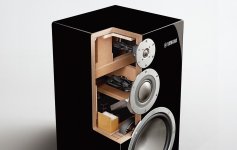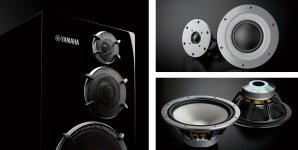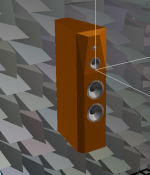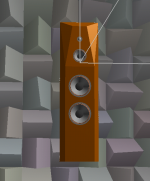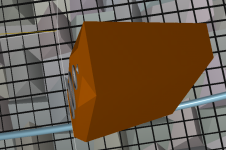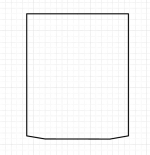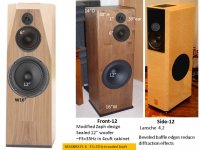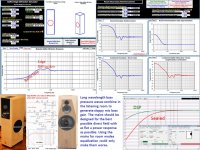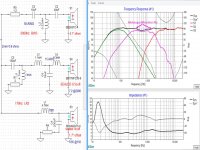Hi to all, long time lurker here on my first post, yep
Realy like this thread and I think we can try to see the thing for what is non desiderable
- bass response archivable with a good 2 way
- Too low SPL suitable only for small room, good sensitivity is always ok
In the past I'd love small MR 13cm or dome too but I'm asking if is only my experience that the voice in such configuration is always seam to me a little small, hiperdetalied but far from realistic
Realy like this thread and I think we can try to see the thing for what is non desiderable
- bass response archivable with a good 2 way
- Too low SPL suitable only for small room, good sensitivity is always ok
In the past I'd love small MR 13cm or dome too but I'm asking if is only my experience that the voice in such configuration is always seam to me a little small, hiperdetalied but far from realistic
I was talking with the OP as shown by it being a response to his questions in the pasted quote above. The OP has already posted that he is working on something inspired by the basszilla speaker but is busy this weekend.Question: who is "you"? The whole thing was Aattos idea, so I guess it would be natural to let Aatto get the ball rolling.
Hi mbrennwa, I'm very humbled to be considered on such an undertaking but please realize that others may be in a better position to take on this challenge. For one, I'm not flushed with lots of cash so utilizing drivers I currently have would be required. I was strongly considering the SB 34NRX75-6 12" woofers to go along with the SB 15MFC30-8 mids and SS R2604/8330 tweeters that I already have on hand. Secondly, I would not be able to commit to working on building this until late November. Then I'M laid off work and could dedicate significant time to this project. Lastly, everything that I have built thus far has been with minimal tools. So, if fancy wood working skills is required or necessary then I'm not the perfect guinea pig. As for the kind of speaker I want/ need: I would like to build something along the lines of old Cerwin Vega type speakers that did Rock and Roll music extremely well. Yet still retain the so called audiophile characteristics. In a word, something that can 'Rock' but still play other genres well. The Yamaha NS 5000 that Lojzek posted looks like something to get excited about. Hopefully, I provide enough overall information to go on.
As for the kind of speaker I want/ need: I would like to build something along the lines of old Cerwin Vega type speakers that did Rock and Roll music extremely well. Yet still retain the so called audiophile characteristics. In a word, something that can 'Rock' but still play other genres well. The Yamaha NS 5000 that Lojzek posted looks like something to get excited about. Hopefully, I provide enough overall information to go on.
Best Regards, Rich
Best Regards, Rich
...so I guess it would be natural to let Aatto get the ball rolling. Aatto, do you want to take the lead?
I m trying to put something together and will propose it hopefully soon (I have to work this weekend) see if you guys like it, but i think it would make more sense if an experienced guy take the lead, but in the same time, let's have some plans proposed first ?
That's a great idea! Someone could design a unique baffle shape (maybe with integrated waveguide or horn) for 3D printing, which could be mated to a regular easy to construct box. Perhaps an SEOS shape for high sensitivity, for the low watt tube amp guys. The driver cutout(s) could be included in the design so builders don't need a router. They'd just need to clean up the printed baffle. That would make it DIY, interesting, convenient, unique and progressive.
Last edited:
A few years ago I made a design with a Sonus Faber front look for someone. Because of a lack of time it has never been build.
I post it to offer some ideas.
It is a three way with 2 x 8 inch woofers, 5 inch midrange and a 1 inch dome tweeter. It has a Sonus Faber front look. A little inclination backwards of the midrange – tweeter baffle.
Dimensions W x H x D = 32 x 115 x 56 cm. See attached figures. I should make the cabinet less deep now.
At that time I had chosen 2 x Eton 8N402 woofer, Accuton C90 midrange and Scanspeak Be tweeter D3004-668000 tweeter.
I should choose other driver types, because this set is rather expensive. But keeping the combination 2 x 8 inch woofer, 1 x 5 inch midrange and 1 x 1inch dome.
Choosing the crossover midrange - tweeter around 2 kHz. In that way with the 5 inch midrange, there is no real need for a tweeter wave guide to keep the power response flat (constant directivity).
Some specs taht can be created with such concept:
- Overall sensitivity around 90dB @ 1m, 2.83Vrms, choosing the appropriate drivers.
- F3 around 40 Hz; woofer closed box system. For a woofer operating in the low medium frequency range I prefer closed box.
- Maximum SPL depends on driver choice w.r.t. maximum excursion and power of the driver, especially the woofer. I will calculate that value again to give some idea.
- Crossover: 400 and 2000 Hz to realize a flat power response above 400Hz.
- Crossover can be an analog and/or a digital design.
All types of crossover can be designed, Butterworth, Linkwitz-Riley, elliptical,… low and high orders. All to be defined.
Very interesting to compare different filter topologies using a digital implementation.
If the concept is defined (cabinet, driver choice, crossover type) a complete concept study can be done, starting with the driver data sheets and a first cabinet drawing. SPL, impedance, power response of complete system, excursion plots, needed amplifier power, SPL at maximum excursion, horizontal and vertical responses can be simulated.
It gives a very good impression of what you can realize with the chosen concept.
When building it, drivers have to be measured carefully on IEC baffle and later also in the cabinet. At least one of these measurements has to be done. With these measurements the final design can be made.
These are all just ideas. I am prepared to give my input to a design.
I should say, shoot on it. What is good, what has to be changed,…to come maybe to an accepted concept for more people…
Anyway once the concept of the speaker is defined, it has a lot of sense to do a complete concept study in simulation. I can help with that.
Paul
I post it to offer some ideas.
It is a three way with 2 x 8 inch woofers, 5 inch midrange and a 1 inch dome tweeter. It has a Sonus Faber front look. A little inclination backwards of the midrange – tweeter baffle.
Dimensions W x H x D = 32 x 115 x 56 cm. See attached figures. I should make the cabinet less deep now.
At that time I had chosen 2 x Eton 8N402 woofer, Accuton C90 midrange and Scanspeak Be tweeter D3004-668000 tweeter.
I should choose other driver types, because this set is rather expensive. But keeping the combination 2 x 8 inch woofer, 1 x 5 inch midrange and 1 x 1inch dome.
Choosing the crossover midrange - tweeter around 2 kHz. In that way with the 5 inch midrange, there is no real need for a tweeter wave guide to keep the power response flat (constant directivity).
Some specs taht can be created with such concept:
- Overall sensitivity around 90dB @ 1m, 2.83Vrms, choosing the appropriate drivers.
- F3 around 40 Hz; woofer closed box system. For a woofer operating in the low medium frequency range I prefer closed box.
- Maximum SPL depends on driver choice w.r.t. maximum excursion and power of the driver, especially the woofer. I will calculate that value again to give some idea.
- Crossover: 400 and 2000 Hz to realize a flat power response above 400Hz.
- Crossover can be an analog and/or a digital design.
All types of crossover can be designed, Butterworth, Linkwitz-Riley, elliptical,… low and high orders. All to be defined.
Very interesting to compare different filter topologies using a digital implementation.
If the concept is defined (cabinet, driver choice, crossover type) a complete concept study can be done, starting with the driver data sheets and a first cabinet drawing. SPL, impedance, power response of complete system, excursion plots, needed amplifier power, SPL at maximum excursion, horizontal and vertical responses can be simulated.
It gives a very good impression of what you can realize with the chosen concept.
When building it, drivers have to be measured carefully on IEC baffle and later also in the cabinet. At least one of these measurements has to be done. With these measurements the final design can be made.
These are all just ideas. I am prepared to give my input to a design.
I should say, shoot on it. What is good, what has to be changed,…to come maybe to an accepted concept for more people…
Anyway once the concept of the speaker is defined, it has a lot of sense to do a complete concept study in simulation. I can help with that.
Paul
Attachments
Last edited:
Hi Paul
Cool! The way I see this project is that we are trying to come up with a design for a high-quality speaker that is an easy entry for newbies or less experienced DIYers. This means the enclosure should be easy to make. The large bevels on your design may be a bit on the tricky side for such builders.
I think bevels/chamfers are usually not acoustically effective anyway (except maybe towards the upper end of the audible spectrum). Siegfried Linkwitz writes "With most speaker cabinets the radius or chamfer is acoustically too small and is primarily cosmetic.", and he has extensive measurements on baffle diffraction here. My own measurements seem to support this, and I also confirmed that the typical baffle diffraction issues with flat rectangular baffles can be avoided by placing the drivers asymmetrically on the front (golden ratio is king!). See here (sorry for the German, but I hope you get the point -- just ask if it's not clear). A simple flat and rectangular baffle is not acoustically worse than a chamfered baffle, although the marketing departments of the big audio companies may say something else (I believe they do it because some people like the looks of large chamfers).
In any case, I'd vote for a simple flat front that is easy to make, allowing an easy entry to the DIY world for newbies.
Cool! The way I see this project is that we are trying to come up with a design for a high-quality speaker that is an easy entry for newbies or less experienced DIYers. This means the enclosure should be easy to make. The large bevels on your design may be a bit on the tricky side for such builders.
I think bevels/chamfers are usually not acoustically effective anyway (except maybe towards the upper end of the audible spectrum). Siegfried Linkwitz writes "With most speaker cabinets the radius or chamfer is acoustically too small and is primarily cosmetic.", and he has extensive measurements on baffle diffraction here. My own measurements seem to support this, and I also confirmed that the typical baffle diffraction issues with flat rectangular baffles can be avoided by placing the drivers asymmetrically on the front (golden ratio is king!). See here (sorry for the German, but I hope you get the point -- just ask if it's not clear). A simple flat and rectangular baffle is not acoustically worse than a chamfered baffle, although the marketing departments of the big audio companies may say something else (I believe they do it because some people like the looks of large chamfers).
In any case, I'd vote for a simple flat front that is easy to make, allowing an easy entry to the DIY world for newbies.
In any case, I'd vote for a simple flat front that is easy to make, allowing an easy entry to the DIY world for newbies.
Hi Mbrennwa
I agree to keep the cabinet simple.
Concerning the bevels, for that speaker I have chosen very smooth edges for the bevels around tweeter and midrange, see the top view in image 1. The radiation is not bad and better than a front with only 90 degree edges.
Simulations in Leap (it has a good diffaction simulator) show that a slow curved front to the sides has a very good radiation pattern.
If you make a front with a top view like shown in image 2, there is already a lot of improvement compared with only 90 degree edges on the front.
I think that such front is not so complicated to built.
Placing the drivers asymmetric on the front is a solution on axis. Off axis there is still a problem. It also makes the horizontal radiation pattern asymmetric, I don't like so much.
Paul
Attachments
Last edited:
I bet this one would have found a few fans that'd consider building it.
The NS-5000 may be a bit difficult to copy,, but it's a really nice goal. I would be very interested.
I would like to se a regular square but well made and easy to build box. Good quality drivers, a 12" closed box bass, 6.5" mid and a tweeter in a small off the shelf wg to nicely match directivity to the mid. A crossover for regular placement but also one with minimal or no bafflestep for near wall placement.

The $172 SB_Acoustics 12" SB34NRX75-6 with an Fs of 19Hz is designed for superior transients from sealed woofer operation, and models to -F3 ~ 36Hz in a 4cuft sealed volume. Google Zaph SB12.3 kit documentation. This MTM-W box can be modified for TM-WGood quality drivers, a 12" closed box bass, 6.5" mid and a tweeter. A crossover for regular placement but also one with minimal or no bafflestep for near wall placement.
A low diffraction Avalon-style cabinet is a basic box with a 2x-3x thick front baffle with 3 deep top bevel cuts which can be done with a hand saw. Since a 3-way woofer crossover will start at -F3 ~150Hz, this 12" woofer can also be mounted on the side of a narrow cabinet.
Based upon your budget, the midrange could be the $72 6.5" SB17NRX35-8 (or polycone SB17MFC35-8) or the Satori MW16P-8. Using NdFeB, the $33 1" dome tweeter SB26STCN-4 has a 2" diameter body which reduces C-to-C lobing effects. The $53 1.1" SB29RDC-4 dome tweeter has several proven lower frequency crossovers to the SB17NRX35-8. You will find diy-members with completed 2-way SB17NRX35-8 + SB29RDC-4 who will want to just add your woofer design.
Attachments
Last edited:
What I'm missing in this discussion is figuring out what kind of speaker people want. Sure, the vote obviously is for a 3-way.
The main question I would ask myself is: what kind of speaker would work best in my room. What properties should it have to have a shot of collaborating with my room, so I can expect great results.
This, to me, is much more important than figuring out which drivers to use. In fact, the outlines of the type of speaker output desired often dictates which drivers would be suitable to use.
A good example of such thoughts can be seen in a thread like tis: http://www.diyaudio.com/forums/multi-way/284117-pseudo-coaxial-narrow-directivity-horbach-keele-filters-3.html#post5501424
An innovative design working towards a goal. In my humble opinion that's how one gets ahead.
The main question I would ask myself is: what kind of speaker would work best in my room. What properties should it have to have a shot of collaborating with my room, so I can expect great results.
This, to me, is much more important than figuring out which drivers to use. In fact, the outlines of the type of speaker output desired often dictates which drivers would be suitable to use.
A good example of such thoughts can be seen in a thread like tis: http://www.diyaudio.com/forums/multi-way/284117-pseudo-coaxial-narrow-directivity-horbach-keele-filters-3.html#post5501424
An innovative design working towards a goal. In my humble opinion that's how one gets ahead.
budget, impedance and sensitivity might be important requirements.
Budget is stretchable, as people voted it can go over 500$ but nothing crazy, and I think maybe keep it to maximum 1500$ give us a wide range of options and still reasonable (for some, not including me !) impedance ? anything 4 to 8, I prefer 8. sensitivity, as it has direct relation with quality of the drivers, I would say 87-88 and above, something more class A and tubes friendly.
Personally i would like to propose a more affordable version and one high-end version.
It is good to see more people participating here
Last edited:
...
A good example of such thoughts can be seen in a thread like tis: http://www.diyaudio.com/forums/multi-way/284117-pseudo-coaxial-narrow-directivity-horbach-keele-filters-3.html#post5501424
An innovative design working towards a goal. In my humble opinion that's how one gets ahead.
that's some design alright and beyond my understanding

Its a design that's certainly a step up from the usual 3 way, at least in my book.
It's something the members here are capable of, and uses innovative ways to make sure the in room results stand a chance of working together...
A speaker can only perform as good as the room it's in, getting the speaker to work with the room allows one to get more pleasant results.
Of course one would have to know what results you actually want. The thread:
Crossover: Staying within 3dB currently has a lot of interesting discussion about that subject.
Rather than just designing another 3 way, wouldn't it be smart to first find out what it is you want from it? It's been said before on this thread, a spec should help with that.
It will remain difficult to create a project that a group of people are interested in. Interested enough to build a set for themselves. Though if you work at it, and document each step, taking your time and the help of the forum to get good results, more people will get inspired by it and use it as a guide or base to build their own version of it. But first think about what it is you want to achieve in your room. What is the goal. That by itself will dictate what kind of speaker could give you results like that.
It's something the members here are capable of, and uses innovative ways to make sure the in room results stand a chance of working together...
A speaker can only perform as good as the room it's in, getting the speaker to work with the room allows one to get more pleasant results.
Of course one would have to know what results you actually want. The thread:
Crossover: Staying within 3dB currently has a lot of interesting discussion about that subject.
Rather than just designing another 3 way, wouldn't it be smart to first find out what it is you want from it? It's been said before on this thread, a spec should help with that.
It will remain difficult to create a project that a group of people are interested in. Interested enough to build a set for themselves. Though if you work at it, and document each step, taking your time and the help of the forum to get good results, more people will get inspired by it and use it as a guide or base to build their own version of it. But first think about what it is you want to achieve in your room. What is the goal. That by itself will dictate what kind of speaker could give you results like that.
That is such neat idea, and ideas like this will make this project(s) unique and it is IMHO what we need to make a unique design ( not necessary this one since it may not suits a lot of people ), the problem is something like that is way beyond my limited knowledge so it is good to see unique ideas here as long as we have people willing to lead and prototyping it. the good part is we are not in a hurry to jump into anything.
Last edited:
- Status
- Not open for further replies.
- Home
- Loudspeakers
- Multi-Way
- Open source speaker project?
